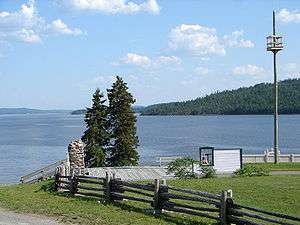Fort Témiscamingue
Fort Témiscamingue was a trading post from the 17th century in Duhamel-Ouest, Quebec, near Ville-Marie, Canada, located on the fur trade route on the east shore of Lake Timiskaming. The fort is a National Historic Site, operated as part of the national park system by Parks Canada, in partnership with the Timiskaming First Nation.[1][2]
| Fort Témiscamingue | |
|---|---|
| Ville-Marie | |
 Remnants of Fort Témiscamingue with Lake Timiskaming in the background. | |
| Type | Fort |
| Site information | |
| Controlled by | New France; Canada |
| Official name | Fort Témiscamingue National Historic Site of Canada |
| Designated | 1931 |
| Site history | |
| Built | 1679 |
| In use | 1679–1902 |
History

Since Lake Timiskaming is at the northwest "corner" of the Ottawa River where its course turns from west to southeast, the lake is a natural site for a trading post. It was on the main canoe route from Hudson Bay to the Saint Lawrence (James Bay, Moose Factory, Abitibi River, Lake Abitibi, portage, Lake Timiskaming, Ottawa River southeast to Montreal). The lake was about the midpoint of a forty-day journey.[2] The Hudson Bay expedition (1686) was the first European group to use the route.
Circa 1679, Montreal merchants established a fort on the west side of Lake Timiskaming to compete with the English posts on the Hudson Bay, but it was destroyed by the Iroquois in 1688.[3] In 1720, a new Fort Témiscamingue was founded by French merchants[4] on the east side of The Narrows where the two shores of Lake Timiskaming come closer than 250 meters (820 ft) to each other,[5] a former Algonquin encampment site called "Obadjiwan Point" (meaning "the strait where the current flows").[3] After the fall of New France the post was re-occupied by independent traders, the North West Company (1788) and the Hudson's Bay Company (1821). At the insistence of George Simpson (administrator) it was supplied from Moose Factory rather than the more efficient Montreal. After 1863 it was again supplied from Montreal due to improvements in the transportation system. The arrival of lumbermen and later railroads and steamboats transformed the trading post into a general store. In 1887 the main store moved to Ville-Marie, Quebec. The fort lingered on until it was closed in 1902.[6] Around 1980 there were only some standing chimneys,[7] but today there is a historic site.
A Roman Catholic mission originally established at Fort Témiscamingue on the eastern shore of Lake Timiskaming in present-day Quebec was relocated to the Ontario shore of the lake in 1863. The mission comprised a presbytery for the Oblate fathers, a small hospital operated by two Grey Sisters of the Cross, and eventually a frame church.[8]
National historic site

Declared a national historic site in 1931,[3] the site is notable for its cultural and natural heritage. The park's territory is mainly three distinct natural areas: the plateau, the escarpments and the lowlands. Overall, over 80% of the total area of the park is a wooded area with approximately 20 different stands and a number of plants from the climatic forest type of the Laurentian maple stand and the Upper St. Lawrence forest sub-region.[5] Of particular interest is a forest of cedar trunks so twisted that it was nicknamed the "Enchanted Forest".[2]
Of the fort itself not much remained, but a modern visitor's centre, exhibits, and reenactments highlight the cultural history of the place.
References
- Fort Témiscamingue. Directory of Federal Heritage Designations. Parks Canada. Retrieved 28 March 2012.
- Christina Romualdo; Olivia Stefanovich (14 July 2019). "Parks Canada strikes 1st agreement with Indigenous group to run national historic site". CBC News. Retrieved 14 July 2019.
- Conseil de la culture de l'Abitibi-Témiscamingue, Cultural Heritage and Tourism Discovery Guide, ISBN 2-9806153-2-3
- Historic Sites and Monuments Board of Canada
- "Natural Wonders & Cultural Treasures". Parks Canada. Retrieved 2008-09-29.
- Parks Canada, Fort Témiscamingue National Historic Site leaflet, ISBN 0-662-66300-4
- Elizabeth Browne Losey, "Let Them be Remembered:The Story of the Fur Trade Forts",1999
- Ontario Heritage Trust Timiskaming Mission Archived 2012-03-20 at the Wayback Machine. Heritagefdn.on.ca. Retrieved on 2012-05-15.
External links
| Wikimedia Commons has media related to Fort Témiscamingue. |